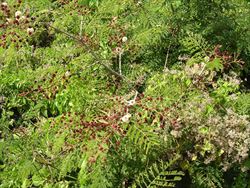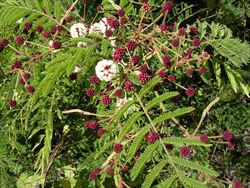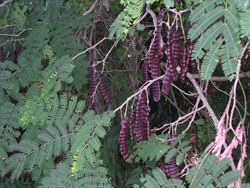Soap-pod, It is also known as soap-nut, soap pod wattle.
Pacific Pests, Pathogens, Weeds & Pesticides - Online edition
Pacific Pests, Pathogens, Weeds & Pesticides
Soap-pod (517)
Senegalia rugata; previously, it was known as Acacia concinna, Acacia rugata, Mimosa rugata. It is a member of the Fabaceae.
Asia, Africa (Madagascar, Mauritius, Reunion), South America (Brazil), the Caribbean (Jamaica), Oceania. It is recorded from Australia, Fiji, Papua New Guinea, and New Caledonia. It is native to China and tropical Asia.
An invasive spreading plant that starts as a shrub, but can climb and scramble like a vine when competing for light, forming dense thickets in sugarcane fields, and pastures, and in both primary and secondary rainforests (Photo 1). It also occurs in disturbed habitats, such as riverbanks, forest margins and forest gaps. Found from lowlands to 1500 masl.
Stems up to 20 m, sometime taller, thick, up to 10 cm diameter, branched, with numerous curved (up to 2 mm long) thorns. Leaves with short stalks (1.5-3.5 cm), and five to seven leaflets (3-7 cm long), on opposite sides of the stem (Photos 2&3). Each leaflet further divided into 12-18 pairs of smaller leaflets (approximately 3-9 mm long and 2-2.5 mm wide). The stems bearing the leaflets are thorny, and hairy. Inflorescence (collection of flowers) with two or three stalks (1-2.5 cm long) born from the axils of the upper leaves, bearing round, cream to pale-yellow (red or purplish-red at first) clusters of flowers (approximately 10 mm diameter) (Photos 4&5). The seed pods are characteristic: at first smooth and fleshy, later, when dry, oblong, wrinkled, blackish, somewhat flattened (4.5-15 cm long and 1.5-2 cm wide), often with constrictions between the six to10 seeds (Photos 6&7).
Seeds are likely spread by birds and other animals, especially cattle; spread of seed pods in water is a possibility, carried from upper catchment areas downstream. Seeds
Heavy infestations of the weed prevent livestock from grazing, access to land and water, and cause injuries to people and livestock. It is invasive in Fiji and New Caledonia; in Reunion and Mauritius it invades lowland forests and riverbanks. In Australia, instances are recorded of the plant escaping from food gardens into the surrounding environments, especially disturbed areas near rainforests, making it an environmental concern because of its threat to native species.
In India, where is it known as shikakai, the seed pods are commonly ground and the powder used as an ingredient in shampoo, as a soap, and as a detergent for washing silks and woollens. Also, leaves and young shoots are eaten, used in chutneys, and as an ingredient in Asian soups. Senegalia rugata is used medicinally for the treatment of skin diseases and wounds, and for diarrhoea, dysentery, haemorrhoids, and as a cure for malaria.
BIOSECURITY
Senegalia rugata is not widely distributed, especially in Pacific island countries. Consequently, those countries not yet infested should consider all likely pathways for entry, and apply quarantine measures accordingly. Particular attention should be given to the popularity of the plant in traditional medicines, as a raw material for shampoo, for hair care, as a food, and the fact that seed could be sent with relative ease across international borders. Note that seed is available for purchase on the Internet.
Where eradication is being considered, countries may wish to note ways to minimise the spread of the weed and legislate to declare the weed a restricted invasive plant under their biosecurity regulations; this means - a person must not release these invasive plants into the environment, give away or sell as a plant or something infested with its seeds. (It might also be necessary to stipulate hygiene measures during the control operations, determining a period of monitoring from the time of removal of the last mature plant.)
BIOCONTROL
Many natural enemies have been recorded, but none have been identified with the necessary host-specificity for biological control programs. Waterhouse provides lists of natural enemies, notes biological control programs on related species, which, seemingly, were unsuccessful, and provides a reminder that cassava is in the same family.
CULTURAL CONTROL
In general, management of Senegalia rugata is not well reported; therefore, the measures suggested here are taken from those of related plants in the Fabaceae family, especially Acacia species.
- Physical & Mechanical:
- Hand-weed seedlings, and dig out small trees, but be careful of the thorns!
- Slash the shrub in order to encourage less-invasive species. It will need to be done regularly.
- Use a large heavy chain dragged across the ground mechanically to pull out mature trees. But note, many smaller plants just bend over and straighten up once the chain has passed. It is not a method suited to uneven ground or along riverbanks as it can cause erosion and damage non-target species.
- Bulldozing, and deep ploughing can be effective, but must be followed up as it brings seeds to the surface.
- Hygiene:
- Treat vehicles and farm machinery. If moving from areas where the weed occurs to those weed-free, wash to remove soil and seed. This is equally important if the machinery is being imported into a country or moved within a country.
- Exclusion:
- Restrict cattle and other livestock to areas as yet uninfested by the weed. If stock is introduced from areas where mature seed are present, confine them to a paddock for a week to ensure all seeds have been passed.
- Movement of sand and soil:
- Do not move soil or sand from infested areas which could contain Senegalia seeds.
CHEMICAL CONTROL
For best results with herbicides, the soil should be moist, and shrubs or trees should be actively growing:
- Foliar applications provide effective control from the time that plants are seedlings to 2 m tall. A wetting agent should be used. It is not recommended near waterways.
- Near waterways, use the cut-basal-bark (or ring bark) treatments: (i) make a 2-3 cm deep cut into the bark right around the trunk at about 75 cm from ground level, and apply herbicide to the wood inside the bark; or (ii) for small trees, cut them down at ground level and then apply herbicide to the cut.
- Away from waterway, larger trees can also be treated with a liquid or granular herbicide. If liquid, wet the bark with the herbicide from about 1 m above the ground, letting the liquid pool at the base of the tree.
In Australia, the following herbicides are registered for prickly acacia (Vachellia nilotica subsp. indica), and are likely to be effective again Senegalia rugata: fluroxypyr, triclopyr, triclopyr + picloram (non-crop and industrial areas, forests and pastures for basal-bark and cut-stump treatments); fluroxypyr (non-crop and industrial areas, forests, and pastures for spraying); hexazinome (agricultural buildings and pastures for soil application - seedlings, shrubs and trees); tebuthiuron (pastures); diuron (bore drains); glyphosate forests, pastures, commercial and industrial areas, agricultural buildings). In Fiji, glyphosate.
--------------------
Note, in the EU, approval to use glyphosate ends in December 2022; its use after that date is under discussion.
____________________
When using a pesticide, always wear protective clothing and follow the instructions on the product label, such as dosage, timing of application, and pre-harvest interval. Recommendations will vary with the crop and system of cultivation. Expert advice on the most appropriate herbicides to use should always be sought from local agricultural authorities.
AUTHORS Grahame Jackson, Makereta Ranadi & Nitya Singh
Information from Pedley L, Maslin BR (2018) Wattle Acaias of Australia. Department of Biodiversity, Conservation and Attractions. Western Australian Herbarium. (https://apps.lucidcentral.org/wattle/text/entities/senegalia_rugata.htm); Senegalia rugata. Wikipedia. (https://en.wikipedia.org/wiki/Senegalia_rugata); and Fern K (2021) Senegalia rugata (Lam.) Britton & Rose. Fabaceae. Tropical Plants Database. (https://tropical.theferns.info/viewtropical.php?id=Senegalia+rugata); and Senegalia rugata (Lam.) Britton & Rose. Plants of the world online. Royal Botanic Gardens, Kew. (https://powo.science.kew.org/taxon/urn:lsid:ipni.org:names:518300-1); and Weed spotters' Network Queensland (2015) DSITIA fact sheet. Queensland Herbarium, and the Department of Agriculture and Fisheries. April Bulletin. (https://www.qld.gov.au/__data/assets/pdf_file/0020/68510/weed-bulletin-apr2015.pdf); and Cairns Region Biosecurity Plan 2019-2024. Cairns Regional Council (https://www.cairns.qld.gov.au/__data/assets/pdf_file/0020/141194/CRCBiosecurityPlan2019_2024.pdf); and DAF (2020) Prickly acacia Vachellia nilotica subsp. indica (Benth) Kyal and Boatwr. Queensland Government. (https://www.daf.qld.gov.au/__data/assets/pdf_file/0007/73753/prickly-acacia.pdf); and from Waterhouse DF (1994) Biological control of weeds: Southeasat Asian Prospects. ACIAR. Canberra, Australia. 302 pp. Photo 3 Dinesh Valke from Thane, India. Acacia concinna. (https://commons.wikimedia.org/wiki/File:Acacia_concinna_(5595830208).jpg). Photo 4 Forestowlet. Acacia sinuata seen in IISc bangalore. (https://commons.wikimedia.org/wiki/File:Acacia_sinuata_02.JPG).
Produced with support from the Australian Centre for International Agricultural Research under project HORT/2016/185: Responding to emerging pest and disease threats to horticulture in the Pacific islands, implemented by the University of Queensland, in association with the Pacific Community and Koronivia Research Station, Ministry of Agriculture, Fiji.










